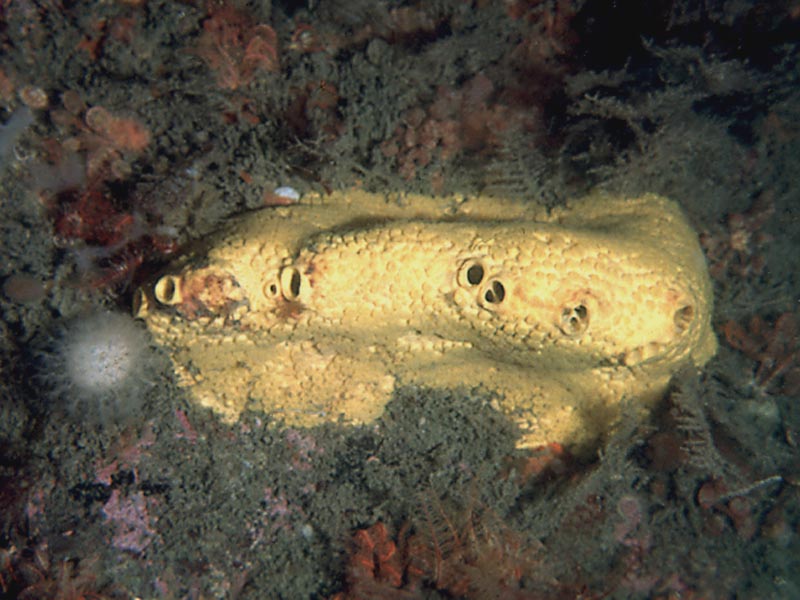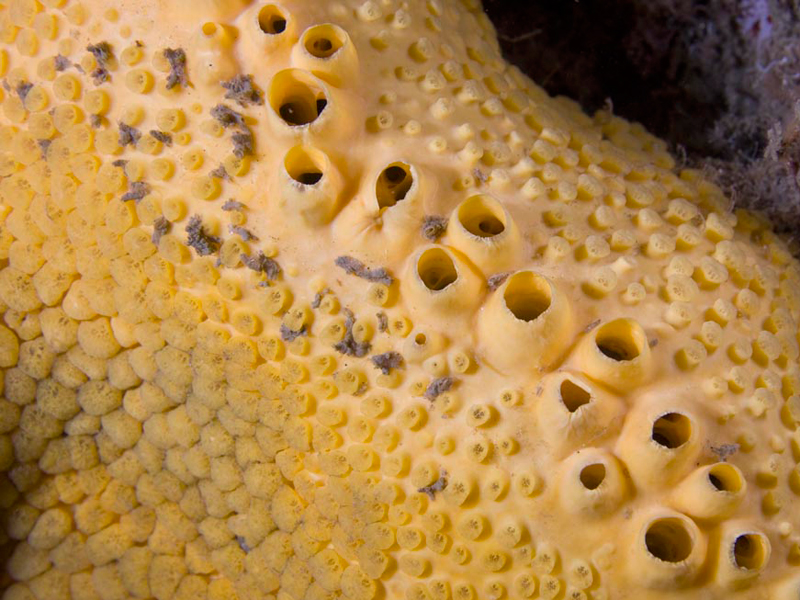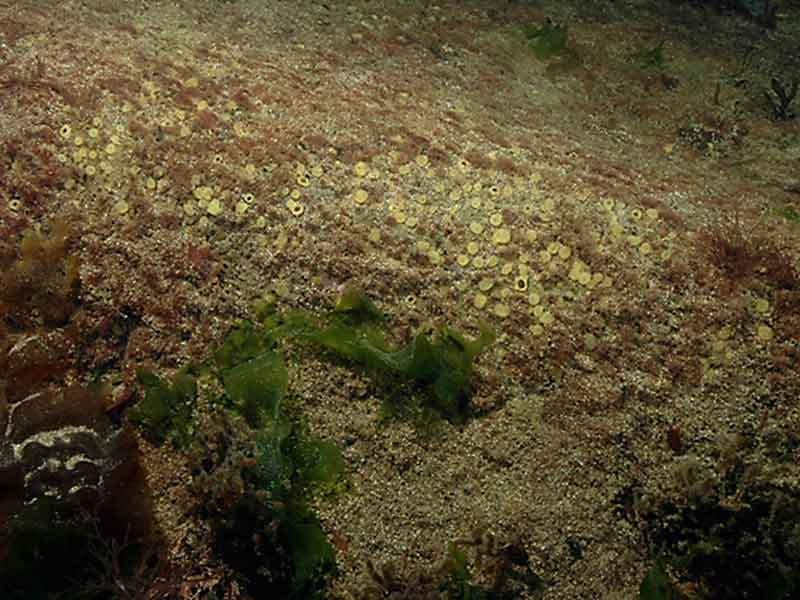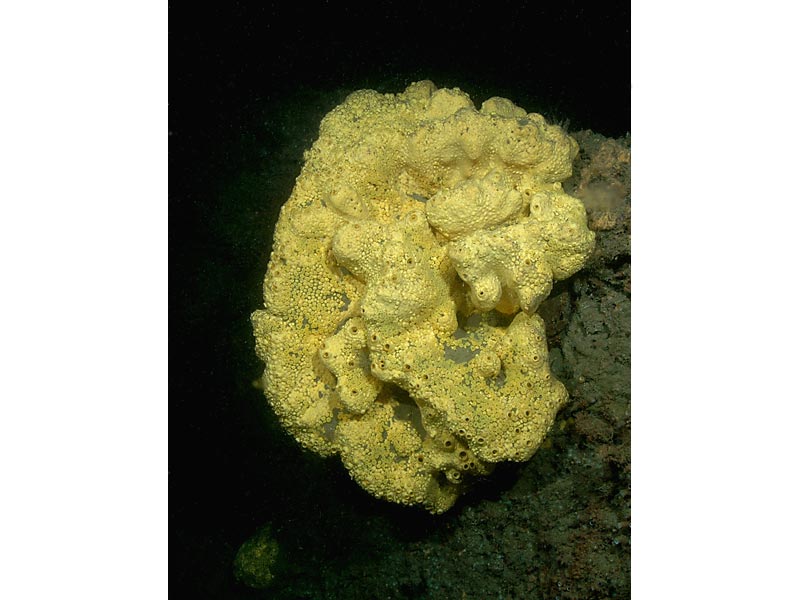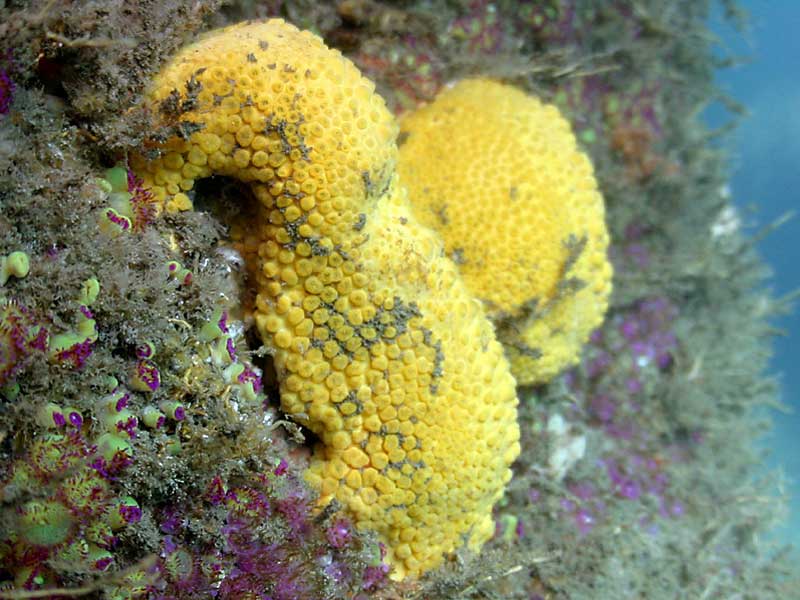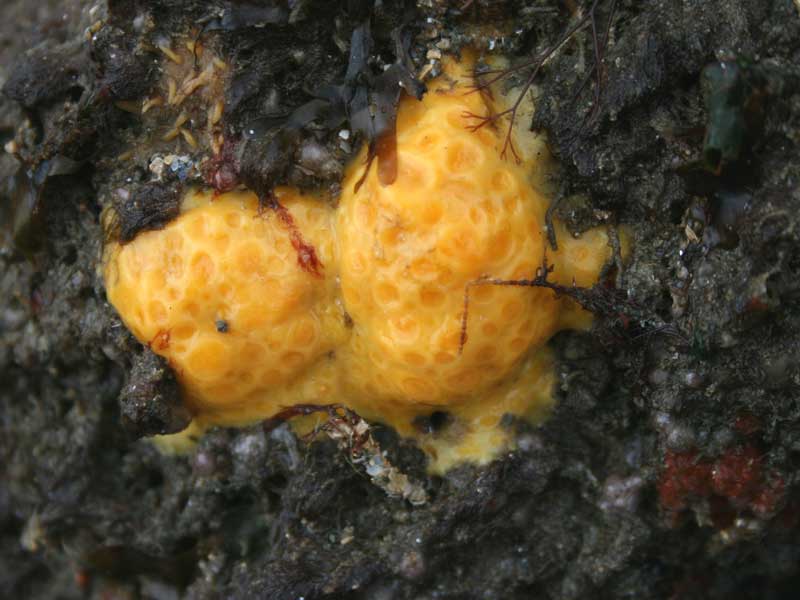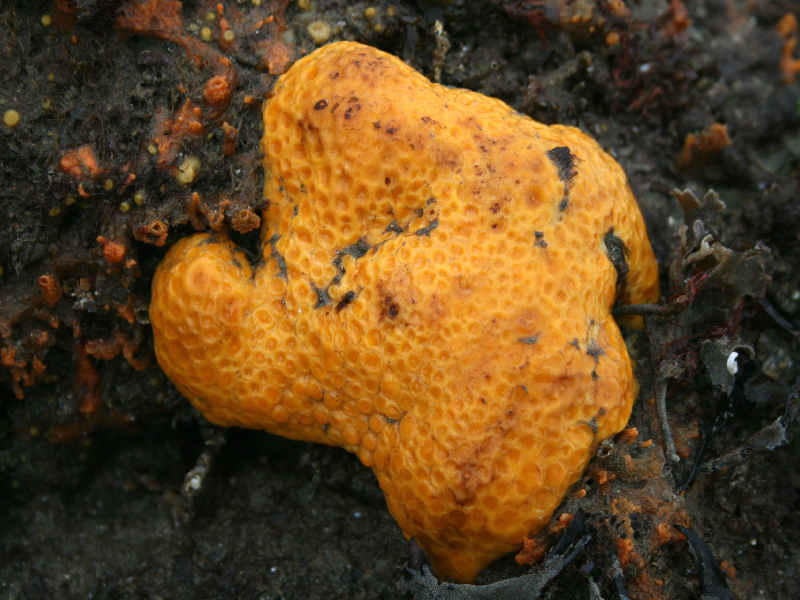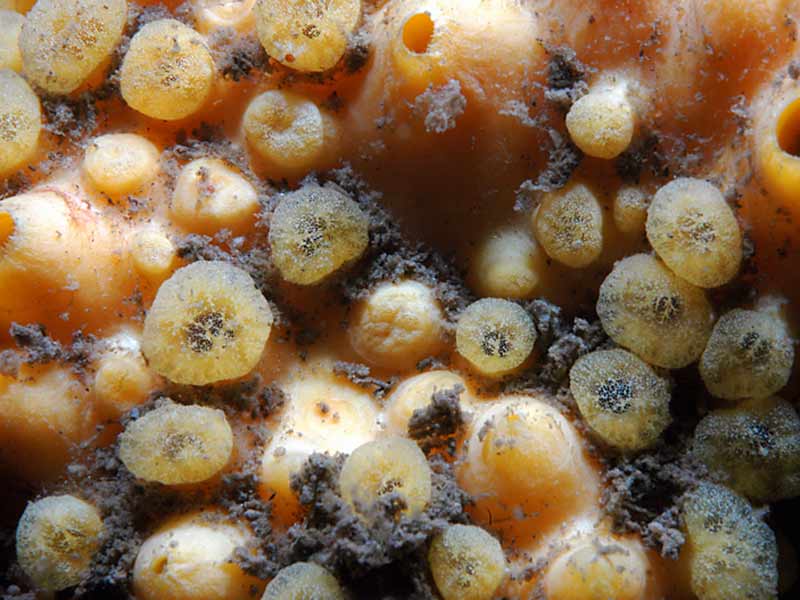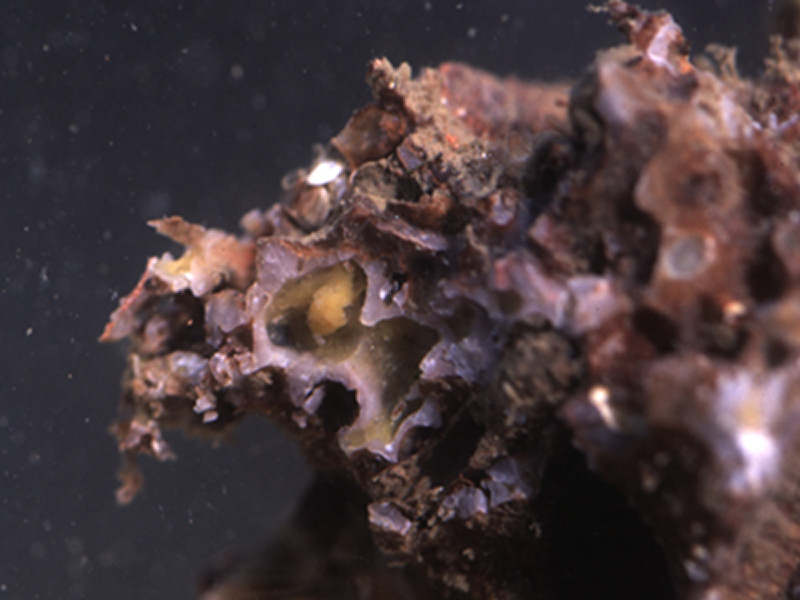Boring sponge (Cliona celata)
Distribution data supplied by the Ocean Biodiversity Information System (OBIS). To interrogate UK data visit the NBN Atlas.Map Help
| Researched by | Emma Snowden | Refereed by | Admin |
| Authority | Grant, 1826 | ||
| Other common names | Sulphur sponge | Synonyms | - |
Summary
Description
A large and conspicuous sponge occurring in two distinct forms. One is the boring form, recognizable as yellow papillae sticking out of limestone (calcareous rock, mollusc shells etc.); the other is a large massive (also known as 'raphyrus'), wall-shaped sponge covered with characteristic flattened papillae.
The massive form has raised, rounded ridges up to 40 cm across. Large oscules with raised rims are found along the tops of the ridges. It often forms a thick plate-like structure standing on its edge with large specimens growing up to 1 m across and 50 cm high. The surface of this stage is evenly covered by tuberculate inhalant papillae. Often bright to deep yellow, becoming darker out of water. Sometimes observed with red colouration (algae) around oscular (exhalent) openings. The whole sponge shows a noticeable decrease in size when removed from the water. The consistency of this sponge is firm and inflexible with a tough outer layer.
Recorded distribution in Britain and Ireland
Cliona celata is widespread around the coast of Britain and Ireland although the massive form is only common around the south west coasts of Britain and lacking in the North Sea. The massive form apparently reaches its easterly limit around Dorset.Global distribution
Widely distributed along all western European coastlines. Distributed from Norway, Iceland and the western Baltic Sea, to the Mediterranean.Habitat
Both forms occur on a variety of coasts ranging from wave exposed, open coasts to silty estuaries, sometimes at considerable depths. The species can withstand sediment.Depth range
-Identifying features
- Bright to deep yellow colouration.
- May have red colouration around oscular openings.
- Evenly distributed inhalant sieve-like openings.
- Firm and inflexible with a tough outer layer.
- The only Cliona species without microscleres (microscopic examination is necessary).
Two forms; boring and massive:
Boring form:
- Visible as yellow lobes (rounded tips of papillae) sticking out of limestone rock, shells etc.
Massive form:
- Often forms a thick plate-like structure standing on its edge, up to 1 m across and 25 cm thick.
- Evenly covered with tuberculate retractable inhalant papillae, 2-5 mm in diameter which project up to 1 cm above the surface when extended but not noticeable when out of water. The surface between these papillae is more or less smooth.
- Large oscules with raised rims are found along the tops of ridges.
Additional information
The massive form develops when the sponge has outgrown its habitat, or when it has completely filled crevices in calcareous rocks into which it cannot bore. Cliona celata is the only excavating sponge in NW Europe developing the massive form; other species of Cliona only occur in the boring form. The boring form is very common in oyster and mussel beds, where they cause some damage to shell fish farming. Favoured shells are Ostrea edulis, Magallana gigas, Crepidula fornicata and Arctica islandica. Cliona celata may be confused with the similarly coloured Cliona lobata but Cliona lobata has much smaller and more numerous papillae.
Listed by
- none -
Bibliography
Gibson, R., Hextall, B. & Rogers, A., 2001. Photographic guide to the sea and seashore life of Britain and north-west Europe. Oxford: Oxford University Press.
Hayward, P.J. & Ryland, J.S. (ed.) 1995b. Handbook of the marine fauna of North-West Europe. Oxford: Oxford University Press.
Howson, C.M. & Picton, B.E., 1997. The species directory of the marine fauna and flora of the British Isles and surrounding seas. Belfast: Ulster Museum. [Ulster Museum publication, no. 276.]
Van Soest, R.W.M., Picton, B. & Morrow, C., 2000. Sponges of the North East Atlantic. [CD-ROM] Windows version 1.0. Amsterdam: Biodiversity Center of ETI, Multimedia Interactive Software. [World Biodiversity Database CD-ROM Series.]
Datasets
Centre for Environmental Data and Recording, 2018. IBIS Project Data. Occurrence dataset: https://www.nmni.com/CEDaR/CEDaR-Centre-for-Environmental-Data-and-Recording.aspx accessed via NBNAtlas.org on 2018-09-25.
Centre for Environmental Data and Recording, 2018. Ulster Museum Marine Surveys of Northern Ireland Coastal Waters. Occurrence dataset https://www.nmni.com/CEDaR/CEDaR-Centre-for-Environmental-Data-and-Recording.aspx accessed via NBNAtlas.org on 2018-09-25.
Fenwick, 2018. Aphotomarine. Occurrence dataset http://www.aphotomarine.com/index.html Accessed via NBNAtlas.org on 2018-10-01
Kent Wildlife Trust, 2018. Kent Wildlife Trust Shoresearch Intertidal Survey 2004 onwards. Occurrence dataset: https://www.kentwildlifetrust.org.uk/ accessed via NBNAtlas.org on 2018-10-01.
Lancashire Environment Record Network, 2018. LERN Records. Occurrence dataset: https://doi.org/10.15468/esxc9a accessed via GBIF.org on 2018-10-01.
Manx Biological Recording Partnership, 2017. Isle of Man wildlife records from 01/01/2000 to 13/02/2017. Occurrence dataset: https://doi.org/10.15468/mopwow accessed via GBIF.org on 2018-10-01.
Manx Biological Recording Partnership, 2022. Isle of Man historical wildlife records 1990 to 1994. Occurrence dataset:https://doi.org/10.15468/aru16v accessed via GBIF.org on 2024-09-27.
National Trust, 2017. National Trust Species Records. Occurrence dataset: https://doi.org/10.15468/opc6g1 accessed via GBIF.org on 2018-10-01.
NBN (National Biodiversity Network) Atlas. Available from: https://www.nbnatlas.org.
OBIS (Ocean Biodiversity Information System), 2025. Global map of species distribution using gridded data. Available from: Ocean Biogeographic Information System. www.iobis.org. Accessed: 2025-03-05
South East Wales Biodiversity Records Centre, 2018. Dr Mary Gillham Archive Project. Occurance dataset: http://www.sewbrec.org.uk/ accessed via NBNAtlas.org on 2018-10-02
South East Wales Biodiversity Records Centre, 2023. SEWBReC Marine and other Aquatic Invertebrates (South East Wales). Occurrence dataset:https://doi.org/10.15468/zxy1n6 accessed via GBIF.org on 2024-09-27.
Citation
This review can be cited as:
Last Updated: 12/09/2007

